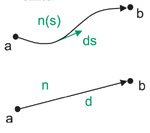Optipedia • SPIE Press books opened for your reference.
Optical Path Length
Excerpt from Field Guide to Geometrical Optics
Optical path length OPL is proportional to the time required for light to travel  between two points.
between two points.

In a homogeneous medium:

Wavefronts are surfaces of constant OPL from the source point. Rays indicate the direction of energy propagation and are normal to the wavefront surfaces.

In a perfect optical system or a first-order optical system, all wavefronts are spherical or planar.
Fermat's Principle
Fermat’s principle: The path taken by a light ray in going from point a to point b through any set of media is the one that renders its OPL equal, in the first approximation, to other paths closely adjacent to the actual path.
The OPL of the actual ray is either an extremum (a minimum or a maximum) with respect to the OPL of adjacent paths or equal to the OPL of adjacent paths.
In a medium of uniform index, light rays are straight lines.
In a first-order or paraxial imaging system, all of the light rays connecting a source point to its image have equal OPLs.
J. E. Greivenkamp, Field Guide to Geometrical Optics, SPIE Press, Bellingham, WA (2004).
View SPIE terms of use.

